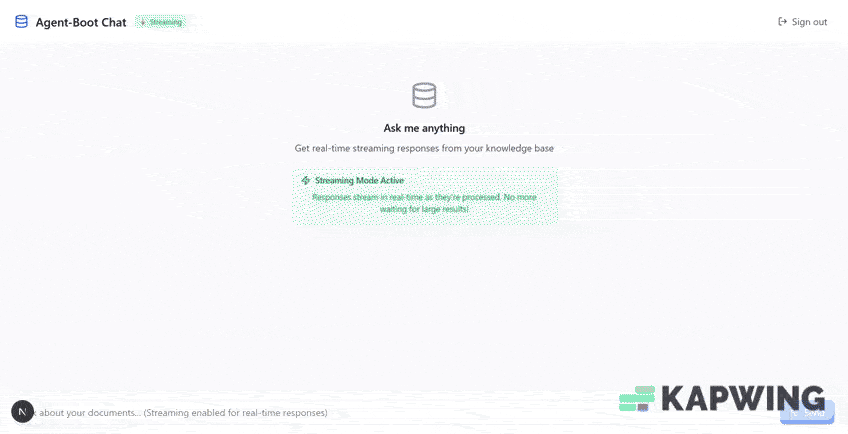Agentic RAG takes Retrieval-Augmented Generation one step further. In traditional RAG, retrieval is a fixed step — fetching context from a knowledge base before generating a response. In Agentic RAG, however, the data source itself becomes a tool in the agent’s toolkit. The agent autonomously decides when and how to query it based on the conversation history, user intent, and reasoning chain, alongside other tools like summarizers or planners. This transforms RAG from a static retrieval process into a dynamic, decision-driven system.
Building such systems requires both intelligence and infrastructure. Python continues to lead in ML research, but scaling agentic workloads demands the concurrency, reliability, and type safety that Go provides. This is where go-api-boot and agent-boot come together — frameworks that unite Go’s high-performance microservice architecture with Python’s ML ecosystem, enabling developers to build fully-agentic RAG systems that think, retrieve, and respond in real time.
go-api-boot: The Muscle Behind Agentic AI Microservices
go-api-boot is a batteries-included Go framework built for AI and microservice developers who want production readiness from day one. It hides the boilerplate — yet keeps Go’s explicitness intact.
Highlights:
- gRPC + HTTP gateway auto-generated from proto files (no manual routing).
- Temporal workflow integration for orchestrating long-running ML jobs.
- MongoDB ODM with vector search support for hybrid retrieval.
- Dependency Injection without code-gen, designed specifically for Go’s type system.
- Zero-config SSL and cloud abstraction across Azure and GCP.
Example minimal bootstrap:
boot, _ := server.New().
GRPCPort(":50051").
HTTPPort(":8080").
WithTemporal("ML_TASK_QUEUE", &client.Options{HostPort: "temporal:7233"}).
RegisterTemporalWorkflow(workflows.RAGWorkflow).
RegisterTemporalActivity(activities.PythonTasks).
Build()
In less than ten lines, we have a gRPC + REST API server with Temporal orchestration, metrics, and structured logging — ready for AI workloads.
agent-boot: Building Agents with Reasoning and Tool Use
agent-boot is a framework for building intelligent agents capable of tool selection using GPT-OSS, tool invocation, optional tool results summarization, and answer generation with reasoning.
It complements go-api-boot perfectly — together, they form a cohesive foundation for building end-to-end Agentic RAG systems that combine structured orchestration with autonomous decision-making.
Using its MCP-style tool definition, developers can bind domain-specific actions to LLM agents:
mcp := agentboot.NewMCPToolBuilder("medicine-rag", "Search and retrieve medical info.").
StringParam("query", "Search Query", true).
WithHandler(func(ctx context.Context, params api.ToolCallFunctionArguments) <-chan *schema.ToolResultChunk {
query := params["query"].(string)
return search.Run(ctx, query)
}).
Summarize(true).
Build()
Each tool runs asynchronously in Go, but can also invoke Python ML tasks through Temporal (through go-api-boot’s Temporal integration) — achieving concurrency and ML richness in one pipeline.
Building a Real Agentic RAG System: medicine-rag
To see these frameworks in action, let’s look at medicine-rag, a RAG application that augments Claude with domain-specific medical knowledge.
medicine-rag has following components:
- Ingestion Workers: Convert PDF to markdown, chunk and embed into MongoDB. Built on temporal integrated in go-api-boot.
- Agentic RAG service: A service that uses agent-boot to use the tools to answer questions and stream the answer real time to the frontend.
- Frontend: A frontend that uses the agentic rag service to answer questions.
Ingestion Workers and Agentic RAG Service are powered by go-api-boot.
go-api-boot ODM with Vector Search and Text Search
The Object Document Mapper (ODM) in go-api-boot comes with first-class support for vector and text search, allowing developers to unify CRUD and hybrid retrieval operations — a critical requirement for knowledge-driven agentic systems.
// genric multi-tenant CRUD operations
type Article struct {
ID string `bson:"_id"`
Title string `bson:"title"`
Content string `bson:"content"`
Embedding bson.Vector `bson:"embedding"` // 768-dim vector
}
func (a Article) Id() string { return a.ID }
func (a Article) CollectionName() string { return "articles" }
// Query
client, err := odm.GetClient(ccfg)
repo := odm.CollectionOf[Article](client, tenant)
article, err := async.Await(repo.FindOneById(grpcCtx, id))
// Vector Search
params := odm.VectorSearchParams{
IndexName: "contentVecIdx",
Path: "embedding", // vector column name
K: 5, // number of results to return
NumCandidates: 20,
}
results, _ := async.Await(repo.VectorSearch(ctx, embedding, params))
// Text Search
params = odm.TermSearchParams{
IndexName: "contentTextIdx",
Path: []string {"content", "title"}, // text columns to search
Limit: 10,
}
results, _ := async.Await(repo.TermSearch(ctx, "golang guides", params))
This unified ODM design makes hybrid search and retrieval a native feature of your Go services.
go-api-boot Temporal Integration
go-api-boot integrates with Temporal to provide a seamless way to orchestrate long-running ML jobs/workers. It allows to run Python ML tasks in Temporal workers and invoke them from Go.
boot, _ := server.New().
WithTemporal("ML_TASK_QUEUE", &client.Options{
HostPort: "temporal:7233",
}).
RegisterTemporalActivity(Activities).
RegisterTemporalWorkflow(GoPythonCombinedWorkflow).
Build()
go-api-boot Microservice APIs & Dependency Injection
go-api-boot supports building first-class gRpc APIs with out-of-the-box support for authentication, authorization, metrics, tracing, logging, and more. Further, it also creates REST proxy APIs for the gRpc APIs without any additional code.
Here, we are registering a gRpc service for the search service and the agent service.
boot, err := server.New().
GRPCPort(":50051").
HTTPPort(":8081").
// Dependency injection
Provide(config).
Provide(azureClient).
Provide(claudeClient).
Provide(mongoClient).
// Temporal workflow registration
WithTemporal(config.TemporalGoTaskQueue, &temporalClient.Options{
HostPort: config.TemporalHostPort,
}).
RegisterTemporalActivity(activities.ProvideActivities).
RegisterTemporalWorkflow(workflows.ChunkMarkdownWorkflow).
RegisterTemporalWorkflow(workflows.PdfHandlerWorkflow).
// gRPC service registration
RegisterService(server.Adapt(pb.RegisterSearchServer), services.ProvideSearchService).
RegisterService(server.Adapt(pb.RegisterAgentServer), services.ProvideAgentService).
Build()
The above dependency injection is build group up, customized for gRpc, temporal, cloud and more. Unlike Wire, it doesn’t generate any code and is more natural for Go.
go-api-boot Streaming for real-time Agentic RAG
go-api-boot provides gRpc streaming support for the microservices. This can be used to stream the results from the agentic rag service to the frontend in real-time.
Below is screen grab of medicine-rag in action.

Further, agent-boot supports gRpc stream to provide updates of internal agent state like tool selection, tool execution, and answer generation with reasoning.
This helps to build real-time Agentic RAG systems with minimal code.
Below is medicine-rag code snippet for streaming the results to the frontend. Here, gRpc server stream is being passed to agent.Execute.
Conclusion
go-api-boot and agent-boot form a powerful foundation for building production-ready Agentic RAG systems. They enable developers to create intelligent agents that can think, retrieve, reason, and stream results in real time — backed by Go’s stability and Python’s flexibility.
The next generation of AI systems won’t just generate answers — they’ll reason, plan, and act. And when they do, go-api-boot will be the muscle that powers them.
Thanks for reading! Explore the source code and examples here:
